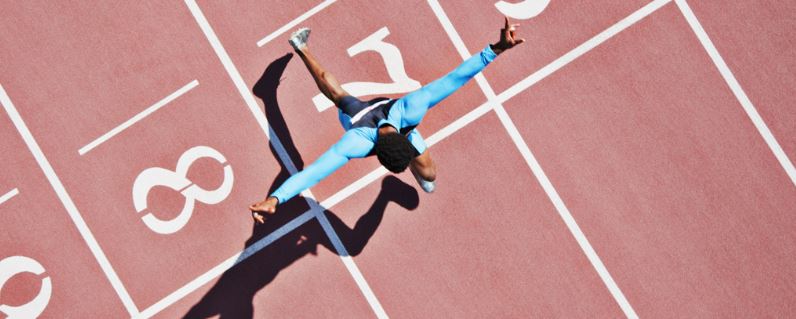


 3:58:36
3:58:36  2024-08-10
2024-08-10  1070
1070

When people think of Olympic athletes, they're often thinking about winners. But competing for an Olympic medal is an unpredictable pursuit that results in disappointment for most.
Success can only be achieved through dedicated training for speed and strength, along with mastery of technique. But that training needs to be balanced with an athlete's biggest fear – sport injury.
When it comes to musculoskeletal health and injury risk, it can be said that exercise (physical activity to maintain health) is good for you whereas sport (competitive physical activity governed by a set of rules) may not be, as it puts an increased load on the body's underlying structures (the muscles, bones and ligaments).
In javelin, forces exceeding seven times bodyweight have been reported in the front leg. And gymnasts perform hundreds of repetitions of movements in training that apply a greater force than their body weight through their wrists and elbows. When the supporting structures of the body are subjected to these forces, a mistake in technique can easily cause an injury.
A 2007 study of sports injuries incurred in competitions or training during the 2007 World Athletics Championships found almost 10% of athletes reported injuries of which 71% happened during competition. A similar study of the 2008 Olympics reported that 11% of athletes were injured, with similar results at London 2012, Rio de Janeiro 2016 and the Tokyo 2020 Olympic Games.
However some sports have much higher injury rates. At the 2018 youth Olympics 43% of rugby players were injured.
Sports injuries come in two categories, acute (or instantaneous) and overuse. There are approximately double the number of acute injuries than overuse and acute injuries are usually the result of a one-off freak event, like a ligament rupture when landing or muscle overload causing a hamstring tear.
Competitors must commit years of their life to laying the foundations of strength to allow their bodies to cope with the physical demands of competition and to produce the forces and movements that are required for success in their sport.
For example, trained sprinters produce significantly more force from their quadriceps than the general population (almost one and a half times more) and Olympic sprinters have been shown to have proportionally greater muscle volume of the muscles that help with sprint performance, such as the Rectus Femoris, a muscle that is part of the quadriceps.
Olympic gymnasts often start training and competing before their teens and gymnastics rules now state that they are not able to compete in the Olympics until the year they turn 16.
For many sports, physical preparation for competition relies on principles of muscular adaptation, to increase muscle size, strength and power. To increase the size of a muscle (known as hypertrophy) the muscle must be overloaded. The overload causes tears of individual muscle fibers, which, during the healing process over the following days, increase the size and strength of the muscle.
Strength training is literally pushing the muscles past breaking point to cause growth and long-term strength gains. During recreational exercise, these tears are usually small and easily repaired by the body. However, professional athletes who want to maximize physical strength, can push training to extremes, resulting in muscle injury that takes weeks or even months to recover from.
Overuse injuries come from micro-trauma (small damage) caused by repetitive loading of the musculoskeletal system during training or competition. A 2018 study of musculoskeletal injury risk found that people who specialize in just one sport are more likely to suffer an overuse injury.
When injuries happen, athletes lose valuable training time which can result in atrophy (reduced muscle size and strength).
For sports that require high levels of strength or speed, there is no other option to win an Olympic medal than to do strength training, and a lot of it.
However, training does not have to be a complete lottery and our understanding of injury risk and how to best mitigate it is constantly changing.
For example, athletes can reduce the chance of injury through a structured periodized training program. This involves factoring in the different performance goals (such as stabilization, strength and power) and preparatory phases to ensure that foundation strength is established before more demanding phases.
These phases are broken down into short-term (days to weeks) medium-term (weeks to months) and long-term (months to years).
Training also needs to manage injury risk factors including genetic ones such as body alignment or limb asymmetries.
Another area of research where scientists are looking to reduce injury risk is movement variabilities, the intentional and unintentional changes in movement that happen when we repeat the same task many times.
Research seems to show that deliberate, small changes in movement can prevent overuse injuries as it redistributes high forces to muscle tissues over time. However, too much movement variability can be as much a problem as too little. For example, a sprinter with high step width variability may be more likely to fall or negatively compensate trying to maintain balance.
In short, it is possible to win an Olympic medal without injury but the strength required to be an elite athlete in many sports can only be achieved through activities which increase the risk of injury.
The athletes whose support teams best understand and manage these risk factors by allowing athletes sufficient recovery time and not overloading training will have less chance of becoming injured.
These training considerations are a small part of what needs to work as planned. Other factors such as psychological responses to injury, environmental and sociological factors and technique dictated by the rules must all come together perfectly for an athlete to earn a place on the podium.
Reality Of Islam |
|

Choosing th

A new NURBS

A research

Researchers
 9:3:43
9:3:43
 2018-11-05
2018-11-05
10 benefits of Marriage in Islam
 7:5:22
7:5:22
 2019-04-08
2019-04-08
benefits of reciting surat yunus, hud &
 9:45:7
9:45:7
 2018-12-24
2018-12-24
advantages & disadvantages of divorce
 11:35:12
11:35:12
 2018-06-10
2018-06-10
 6:0:51
6:0:51
 2018-10-16
2018-10-16
 2:34:48
2:34:48
 2022-01-18
2022-01-18
allah will not answer all your prayers
 6:56:28
6:56:28
 2022-01-01
2022-01-01
 10:43:56
10:43:56
 2022-06-22
2022-06-22
 11:2:27
11:2:27
 2022-10-06
2022-10-06
 8:21:9
8:21:9
 2018-06-21
2018-06-21
 5:57:34
5:57:34
 2023-03-18
2023-03-18
 4:2:19
4:2:19
 2022-10-10
2022-10-10
 5:41:46
5:41:46
 2023-03-18
2023-03-18
| LATEST |